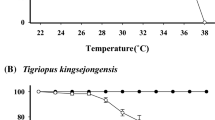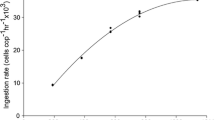Abstract
We have used the cyclopoid copepod Paracyclopina nana to understand responses to the temperature shift. To determine the changes of molecular mechanisms, which would lead to physiological changes in P. nana, we investigated mRNA expression involved in lipogenesis, the area of lipid droplets, the ratio of fatty acids, and life parameters (growth and fecundity) in response to temperature changes (15, 20, and 30 °C) with comparative control at 25 °C. Setting the temperature 25 °C as a standard point, there were increases in mRNA expression, the area of the lipid droplets, and fatty acid composition at temperatures below the standard (15 °C), while all the markers mentioned above significantly decreased at higher temperatures than the standard (25 °C). Through fecundity and growth rate experiments, daily nauplii production was reduced and growth retardation was observed at both 15 and 20 °C, but no noticeable differences in the two parameters were observed at 30 °C compared to the control (25 °C). This study provides a better understanding of the effects of temperature on lipogenesis in copepods.





Similar content being viewed by others
References
van Dooremalen C, Ellers J (2010) A moderate change in temperature induces changes in fatty acid composition of storage and membrane lipids in a soil arthropod. J Insect Physiol 56:178–184
Walther G-R, Post E, Convey P, Menzel A, Parmesan C, Beebee TJ, Fromentin JM, Hoegh-Guldberg O, Bairlein F (2002) Ecological responses to recent climate change. Nature 416:389–395
Hochachka PW, Somero GN (2002) Biochemical adaptation: mechanism and process in physiological evolution. Oxford University Press, Oxford
Lee H-W, Ban S, Ikeda T, Matsuishi T (2003) Effect of temperature on development, growth and reproduction in the marine copepod Pseudocalanus newmani at satiating food condition. J Plankton Res 25:261–271
Rhyne AL, Ohs CL, Stenn E (2009) Effects of temperature on reproduction and survival of the calanoid copepod Pseudodiaptomus pelagicus. Aquaculture 292:53–59
Hays GC, Richardson AJ, Robinson C (2005) Climate change and marine plankton. Trends Ecol Evol 20:337–344
Mauchline J (1998) The biology of calanoid copepods. Adv Mar Biol 33:1–710
Cruz J, Garrido S, Pimentel MS, Rosa R, Santos AMP, Re P (2013) Reproduction and respiration of a climate change indicator species: effect of temperature and variable food in the copepod Centropages chierchiae. J Plankton Res 35:1046–1058
Richardson AJ (2008) In hot water: zooplankton and climate change. ICES J Mar Sci 65:279–295
Pond DM, Tarling GA, Mayor DJ (2014) Hydrostatic pressure and temperature effects on the membranes of a seasonally migrating marine copepod. PLoS One 9:e111043
Sargent JR, Tocher DR, Bell JG (2002) The lipids. In: Halver JE, Hardy RW (eds) Fish nutrition, 3rd edn. Academic Press, San Diego, pp 181–257
Behrouzian B, Buist PH (2003) Mechanism of fatty acid desaturation: a bioorganic perspective. Prostaglandins Leukot Essent Fatty Acids 68:107–112
Leonard AE, Pereira SL, Sprecher H, Huang Y-S (2004) Elongation of long-chain fatty acids. Prog Lipid Res 43:36–54
Uttaro AD (2006) Biosynthesis of polyunsaturated fatty acids in lower eukaryotes. Life 58:563–571
Falk-Petersen S, Hagen W, Kattner G, Clarke A, Sargent J (2000) Lipids, trophic relationships, and biodiversity in Arctic and Antarctic Krill. Can J Fish Aquat Sci 57:178–191
Atkinson A, Meyer B, Stübing D, Hagen W, Schmidt K, Bathmann UV (2002) Feeding and energy budgets of Antarctic krill at the onset of winter—II. Juveniles and adults. Limnol Oceanogr 47:953–966
Pond DW (2012) The physical properties of lipids and their role in controlling the distribution of zooplankton in the oceans. J Plankton Res 34:443–453
Hall JM, Parrish CC, Thompson RJ (2002) Eicosapentaenoic acid regulates scallop (Placopecten magellanicus) membrane fluidity in response to cold. Biol Bull 202:201–203
Schlechtriem C, Arts MT, Zellmer ID (2006) Effect of temperature on the fatty acid composition and temporal trajectories of fatty acids in fasting Daphnia pulex (Crustacea, Cladocera). Lipids 41:397–400
Kattner G, Hagen W (2009) Lipids in marine copepods: latitudinal characteristics and perspective to global warming. In: Arts MT, Brett MT, Kainz M (eds) Lipids in aquatic ecosystems. Springer, New York, pp 257–280
Lee RF, Hirota J, Barnett AM (1971) Distribution and importance of wax esters in marine copepods and other zooplankton. Deep-Sea Res 18:1147–1165
Möller KO, Schmidt JO, St John M, Temming A, Diekmann R, Peters J, Floeter J, Sell AF, Herrmann J-P, Möllmann C (2015) Effects of climate-induced habitat changes on a key zooplankton species. J Plankton Res 37:530–541
Vehmaa A, Brutemark A, Engström-Öst J (2012) Maternal effects may act as an adaptation mechanism for copepods facing pH and temperature changes. PLoS One 7:e48538
Koski M, Kuosa H (1999) The effect of temperature, food concentration and female size on the egg production of the planktonic copepod Acartia bifilosa. J Plankton Res 12:1779–1789
Ikeda T, Kanno Y, Ozaki K, Shinada A (2001) Metabolic rates of epipelagic marine copepods as a function of body mass and temperature. Mar Biol 139:587–596
Bunker AJ, Hirst AG (2004) Fecundity of marine planktonic copepods: global rates and patterns in relation to chlorophyll a, temperature and body weight. Mar Ecol Prog Ser 279:161–181
Hirst AG, Bunker AJ (2003) Growth of marine planktonic copepods: global rates and patterns in relation to chlorophyll a, temperature, and body weight. Limnol Oceanogr 48:1988–2010
Mayor DJ, Sommer U, Cook KB, Viant MR (2015) The metabolic response of marine copepods to environmental warming and ocean acidification in the absence of food. Sci Rep 5:13690
Lee S-H, Lee M-C, Puthumana J, Park JC, Kang S, Hwang D-S, Shin K-H, Park HG, Souissi S, Om A-S, Lee J-S, Han J (2017) Effects of salinity on growth, fatty acid synthesis, and expression of stress response genes in the cyclopoid copepod Paracyclopina nana. Aquaculture 470:182–189
Lee B-Y, Kim H-S, Choi B-S, Hwang D-S, Choi AY, Han J, Won E-J, Choi I-Y, Lee S-H, Om A-S, Park HG, Lee J-S (2015) RNA-seq based whole transcriptome analysis of the cyclopoid copepod Paracyclopina nana focusing on xenobiotics metabolism. Comp Biochem Physiol D 15:12–19
Dahms H-U, Won E-J, Kim H-S, Han J, Park HG, Souissi S, Raisuddin S, Lee J-S (2016) Potential of the small cyclopoid copepod Paracyclopina nana as an invertebrate model for ecotoxicity testing. Aquat Toxicol 180:282–294
Ki J-S, Park HG, Lee J-S (2009) The complete mitochondrial genome of the cyclopoid copepod Paracyclopina nana: a highly divergent genome with novel gene order and a typical gene numbers. Gene 435:13–22
Livak KJ, Schmittgen TD (2001) Analysis of relative gene expression data using real time quantitative PCR and the 2−∆∆CT method. Methods 25:402–408
Hama T, Handa N (1987) Pattern of organic matter production by natural phytoplankton population in a eutrophic lake. I. Intracellular products. Arch Hydrobiol 109:107–120
Strable MS, Ntambi JM (2010) Genetic control of de novo lipogenesis: role in diet-induced obesity. Crit Rev Biochem Mol Biol 45:199–214
Hwang D-S, Lee B-Y, Kim H-S, Lee M-C, Kyung D-H, Om A-S, Rhee J-S, Lee J-S (2014) Genome-wide identification of nuclear receptor (NR) superfamily genes in the copepod Tigriopus japonicus. BMC Genom 15:993
Lee M-C, Han J, Lee S-H, Kim D-H, Kang H-M, Won E-J, Hwang D-S, Park JC, Om A-S, Lee J-S (2016) A brominated flame retardant 2, 2′, 4, 4′ tetrabrominated diphenylether (BDE-47) leads to lipogenesis in the copepod Tigriopus japonicus. Aquat Toxicol 178:19–26
Bell MV, Dick JR, Anderson TR, Pond DW (2007) Application of liposome and stable isotope tracer techniques to study polyunsaturated fatty acid biosynthesis in marine zooplankton. J Plankton Res 29:417–422
Guillou H, Zadravec D, Martin PGP, Jacobsson A (2010) The key roles of elongases and desaturases in mammalian fatty acid metabolism: insights from transgenic mice. Prog Lipid Res 49:186–199
Nanton DA, Castell JD (1998) The effects of dietary fatty acids on the fatty acid composition of the haractacoid copepod, Tisbe sp. for use as a live food for marine fish larvae. Aquaculture 163:251–261
Monroig Ó, Tocher DR, Navarro JC (2013) Biosynthesis of polyunsaturated fatty acids in marine invertebrates: recent advances in molecular mechanisms. Mar Drugs 11:3998–4018
Barbosa AD, Savage DB, Siniossoglou S (2015) Lipid droplet-organelle interactions: emerging roles in lipid metabolism. Curr Opin Cell Biol 35:91–97
Lee RF, Hagen W, Kattner G (2006) Lipid storage in marine zooplankton. Mar Ecol Prog Ser 307:273–306
Carman KR, Thistle D, Ertman SC, Foy M (1991) Nile red as a probe forlipid-storage products in benthic copepods. Mar Ecol Prog Ser 74:307–311
Williams JL, Biesiot PM (2004) Lipids and fatty acids of the benthic marine harpacticoid copepod Heteropsyllus nunni Coull during diapause: a contrast topelagic copepods. Mar Biol 144:335–344
Wodtke E, Cossins AR (1991) Rapid cold-induced changes of membrane order and ∆9-desaturase activity in endoplasmic reticulum of carp liver: a time-course study of thermal acclimation. Biochim Biophys Acta 1064:343–350
Kostal V, Simek P (1998) Changes in fatty acid composition of phospholipids and triacylglycerols after cold-acclimation of an aestivating insect prepupa. J Comp Physiol B 168:453–460
Chakraborty RD, Chakraborty K, Radhakrishnan EV (2007) Variation in fatty acid composition of Artemia salina nauplii enriched with microalgae and baker’s yeast for use in larviculture. J Agric Food Chem 55:4043–4051
Ouraji H, Fereidoni AE, Shayegan M, Asil SM (2011) Comparison of fatty acid composition between farmed and wild indian white shrimps, Fenneropenaeus indicus. Food Nutr Sci 2:824–829
Zhang Z, Liu L, Xie C, Li D, Xu J, Zhang M, Zhang M (2017) Lipid contents, fatty acid profiles and nutritional quality of nine wild caught freshwater fish species of the Yangtze Basin, China. J Food Nutr Res 7:388–394
van der Meeren T, Olsen RE, Hamre K, Fyhn HJ (2008) Biochemical composition of copepods for evaluation of feed quality in production of juvenile marine fish. Aquaculture 274:375–397
Kooijman SA, Troost TA (2007) Quantitative steps in the evolution of metabolic organisation as specified by the Dynamic Energy Budget theory. Biol Rev Camb Philos Soc 82:113–142
Yoshinaga T, Hagiwara A, Tsukamoto K (2000) Effect of periodical starvation on the life history of Brachionus plicatilis O.F. Müller (Rotifera): a possible strategy for population stability. J Exp Mar Biol Ecol 253:253–260
Yoshinaga T, Hagiwara A, Tsukamoto K (2003) Life history response and age-specific tolerance to starvation in Brachionus plicatilis O.F. Müller (Rotifera). J Exp Mar Biol Ecol 287:261–271
Ikeda T, Sano F, Yamaguchi A (2007) Respiration in marine pelagic copepods: a global-bathymetric model. Mar Ecol Prog Ser 339:215–219
Acknowledgements
We thank two anonymous reviewers for their valuable comments on the manuscript. This work was made possible by a grant from the Development of Techniques for Assessment and Management of Hazardous Chemicals in the Marine Environment program of the Korean Ministry of Oceans and Fisheries funded to Jae-Seong Lee.
Author information
Authors and Affiliations
Corresponding author
Electronic supplementary material
Below is the link to the electronic supplementary material.
Rights and permissions
About this article
Cite this article
Lee, SH., Lee, MC., Puthumana, J. et al. Effects of temperature on growth and fatty acid synthesis in the cyclopoid copepod Paracyclopina nana . Fish Sci 83, 725–734 (2017). https://doi.org/10.1007/s12562-017-1104-2
Received:
Accepted:
Published:
Issue Date:
DOI: https://doi.org/10.1007/s12562-017-1104-2




